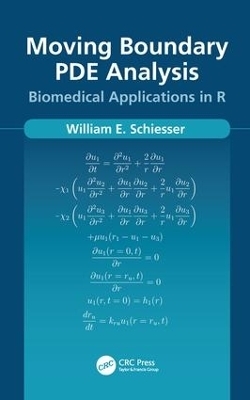
Moving Boundary PDE Analysis
CRC Press (Verlag)
978-0-367-22483-7 (ISBN)
Mathematical models stated as systems of partial differential equations (PDEs) are broadly used in biology, chemistry, physics and medicine (physiology). These models describe the spatial and temporial variations of the problem system dependent variables, such as temperature, chemical and biochemical concentrations and cell densities, as a function of space and time (spatiotemporal distributions).
For a complete PDE model, initial conditions (ICs) specifying how the problem system starts and boundary conditions (BCs) specifying how the system is defined at its spatial boundaries, must also be included for a well-posed PDE model. In this book, PDE models are considered for which the physical boundaries move with time. For example, as a tumor grows, its boundary moves outward. In atherosclerosis, the plaque formation on the arterial wall moves inward, thereby restricting blood flow with serious consequences such as stroke and myocardial infarction (heart attack).
These two examples are considered as applications of the reported moving boundary PDE (MBPDE) numerical method (algorithm). The method is programmed in a set of documented routines coded in R, a quality, open-source scientific programming system. The routines are provided as a download so that the reader/analyst/researcher can use MFPDE models without having to first study numerical methods and computer programming.
William E. Schiesser, emeritus professor at Lehigh University. Schiesser is the Emeritus McCann Professor in the chemical and biomolecular engineering department as well as a former professor in the mathematics department. recently authored several books on computer-based solutions to model real-life phenomena, such as the development of Parkinson’s disease.Schiesser holds a Ph.D. from Princeton University and an honorary Sc.D. from the University of Mons, Belgium. He is the author or co-author of numerous books in his field of research on numerical methods and associated software for ordinary, differential-algebraic and partial differential equations (ODE/DAE/PDEs) and the development of mathematical models based on ODE/DAE/PDEs.
1. PDE Model Formulation. 2. PDE Model Implementation. 3. PDE Model Output. 4. Tumor growth. 5. Plaque Formation in Atherosclerosis. Appendix A1. Test of Spline Regridding. Appendix A2. Test of Moving Boundary Algorithm Spline Formulation. Appendix A3. Test of Moving Boundary Algorithm Finite Difference Formulation.
| Erscheinungsdatum | 14.06.2019 |
|---|---|
| Zusatzinfo | 22 Tables, black and white; 86 Illustrations, black and white |
| Verlagsort | London |
| Sprache | englisch |
| Maße | 156 x 234 mm |
| Gewicht | 335 g |
| Themenwelt | Mathematik / Informatik ► Mathematik ► Analysis |
| Mathematik / Informatik ► Mathematik ► Angewandte Mathematik | |
| Medizin / Pharmazie ► Physiotherapie / Ergotherapie ► Orthopädie | |
| Studium ► 1. Studienabschnitt (Vorklinik) ► Physiologie | |
| Technik ► Medizintechnik | |
| ISBN-10 | 0-367-22483-6 / 0367224836 |
| ISBN-13 | 978-0-367-22483-7 / 9780367224837 |
| Zustand | Neuware |
| Informationen gemäß Produktsicherheitsverordnung (GPSR) | |
| Haben Sie eine Frage zum Produkt? |
aus dem Bereich


